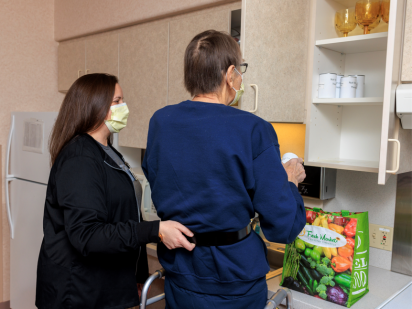For most of us, our daily morning routine takes little thought. The alarm goes off, we get out of bed, plod to the bathroom, take a shower, brush our teeth, fix our hair and prepare for the day. Dressing may require zipping trousers, buttoning shirts, tying shoes – all of which we do without much effort.
Unless we can’t.
When an event or illness change one’s ability to complete everyday tasks, occupational therapists (OT) and occupational therapy assistants (OTA) help individuals regain daily life skills, based on personal interests and needs. OTs teach individuals to learn new ways to be as independent as possible.
That was the case for Larry Anderson, a recent patient in Trinity’s Occupational Therapy program. Anderson, 75, originally came to Trinity Hospital for a routine biopsy, but during the procedure, he had a heart attack that required stent placement in four arteries. Recovery required Anderson to spend five weeks in the hospital, unable to move his hands or arms, as his breastbone healed.
An avid athlete and daily exerciser, Anderson was surprised at his level of fatigue and weakness once he was able to move around. “At four weeks, I was able to get up; I walked two steps to the wall and two steps back. I was panting. After lying in bed for so long, it felt like I was lifting the Empire State Building,” he said. “I had no idea my body could deteriorate so quickly.”
Once he was given the green light for rehab, Anderson was moved to RehabCare Occupational Therapy at St. Joseph’s Hospital. To build strength and stamina, Kate Robert, certified occupational therapy assistant, had Larry use an upper body ergometer, otherwise known as the “arm bike.” Additionally, he worked with weights, ropes and pulleys on push/pull exercises to build upper body strength, flexibility and balance. Robert would set a timer and add resistance as Armstrong’s strength improved.
The hard work came when he had to relearn simple things such as undressing, moving to the shower, turning on the water, brushing his teeth and shaving. “Most of these things you take for granted,” Anderson said. “The best feeling was the day I could go to the bathroom by myself.”
More advanced therapy sessions took Anderson to the simulated apartment where he completed basic kitchen chores such as unpacking and putting away groceries, loading a dishwasher and removing items from the refrigerator. He passed with flying colors.
“I’ve had excellent care,” Anderson said. “The therapists are so kind, which is important. They are here to help get me home.”
Occupational therapy can take place in a variety of settings. Trinity’s OTs and OTAs work in the acute care hospital, outpatient clinic, pediatrics, NICU, mental health services, Child and Adolescent Partial Hospitalization Program, Home Health and Trinity Homes. Because occupational therapy overlaps many facets of daily life skills, OTs are often part of a comprehensive team that works closely together and may include doctors, nurses, case managers/social workers, physical therapists and speech therapists. To coin a popular phrase, “It takes a village.”
Sascha Demory is a nurse who has utilized outpatient therapy twice due to hand surgery. A few years ago, Demory developed trigger finger in both thumbs, a condition in which a finger gets stuck in a bent position due to inflammation of tendons that flex the fingers. After having surgery on each hand, she had occupational therapy to strengthen and increase range of motion in her hands. In September 2021, Demory’s trigger finger reappeared, affecting a different finger, and requiring another surgery.
“The first two surgeries went well, and my hands felt amazing,” she said. However, she developed a surgical site infection after her most recent surgery, which was very painful and required yet another surgery. “There was a lot of scar tissue and when the doctor mentioned I might experience a loss of strength, I decided to work really hard and do exactly what my OT recommended,” she said.
Demory credits her therapist for keeping her on task, both physically and mentally. Demory’s hand exercises to build strength and dexterity included making a tight fist, finger bending, finger to finger movements and using scissors.
“My therapist had me do every exercise in the book, and she kept it fun. When you’re working on function, little things are so important, physically and emotionally,” she said. “They measured the angles at which my joint bends and extends, my grip strength and documented pain level. They kept me focused on progress. At about week six, I picked up a cup of coffee and my therapist pulled out her pad and said ‘Hey, that’s a win!’
“I listen to my therapists and do what they tell me to do,” she added. “Their goal is to someday kick me out of therapy. My goal is to wave to my daughter and not have it hurt.

